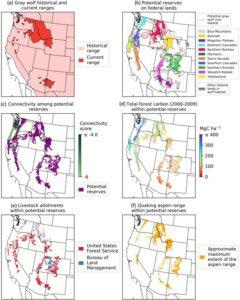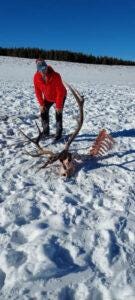Restoration of wolves in the Western Rewilding Network would help “heal” the West. Photo George Wuerthner
A new study published in Bioscience proposes rewilding the West with a system of wildland reserves to restore the ecological integrity of the landscape. The proposal follows President Biden’s plan to manage 30 percent of the United States landscape for biodiversity and climate protection goals.
The plan called the Western Rewilding Network,” would set aside 11 large reserve areas. Livestock grazing impacts more western landscapes and species and thus would be terminated. According to the proposal, two keystone species: the gray wolf and the North American beaver, would be restored.
Willows and riparian vegetation improved by beaver. Beaverdam Creek, Yellowstone NP. Photo George Wuerthner
Beaver are well-known for their ability to repair watersheds, increase water retention, reduce sedimentation, store carbon, and promote riparian vegetation. These are critical factors in an already arid, drought-impacted West where 70-80% of all species depend on the narrow band of green water-influenced foliage known as riparian areas.
Willows that have gain height and size due to wolf influence on browsing elk in Yellowstone NP. Photo George Wuerthner
Wolves, as apex predators, influence ungulate (i.e., elk, deer) populations and habitat use, plus provide food as carrion for other species like ravens, eagles, coyotes, and bears. They have been shown to promote healthy riparian areas by reducing ungulate browsing and use.
Remains of bull elk killed by wolf pack, Yellowstone National Park. Photo George Wuerthner
In part due to these influences, as well as the reduction in livestock grazing, the authors believe the creation of this reserve system would benefit many of the 92 threatened and endangered species across nine taxonomic groups: five amphibians, five birds, two crustaceans, 22 fishes, 39 flowering plants, five insects, 11 mammals, one reptile, and two snail species. As a result, the list probably understates the benefit for species.
The reserve areas with the highest percentage of Endangered and Threatened Species were the Southern Rockies of Colorado and New Mexico and the Mogollon Plateau of Arizona and New Mexico. Not surprisingly, livestock grazing was the principal land use responsible for species endangerment. Indeed, in 7 of the 11 potential reserves, at least half of the listed species are threatened by livestock grazing.
The study was pulled together by lead author William Ripple, who has been a leader in alerting the world to the threats posed by climate change. The study also includes 19 co-authors, including, Christopher Wolf, Michael K Phillips, Robert L Beschta, John A Vucetich, J Boone Kauffman, Beverly E Law, Aaron J Wirsing, Joanna E Lambert, Elaine Leslie, Carly Vynne, Eric Dinerstein, Reed Noss, George Wuerthner, Dominick A DellaSala, Jeremy T Bruskotter, Michael Paul Nelson, Eileen Crist, Chris Darimont, and Daniel M Ashe.
Public lands livestock is the largest factor in species endangerment in the West. Photo George Wuerthner
If you are paying attention to predators, livestock grazing, conservation biology, land protection, climate, and ethical issues, these names should be familiar to readers.
Wolves currently occupy approximately 14% of its historic range across the West. Similarly, beaver have been reduced or extirpated from an estimated 90-98% of their former range.
The first step was to identify core wolf habitat on federal lands across the West that were a minimum of 5000 square kilometers or 1,235,527 acres. Corridors linking these core habitats were also mapped to preclude isolation and genetic inbreeding.
Next, the presence of threatened and endangered plant and animal species, including subspecies and distinct population segments, was identified with at least 10% of their ranges within any reserve. Then for each species, any threats from livestock grazing, logging, mining, and oil and gas drilling were determined.
Livestock grazing, logging, and oil and gas development all release Greenhouse Gas Emissions, so eliminating these uses from a significant portion of the West would aid the United States in reaching its climate goals.
In addition, the current effort of some western states such as Idaho, Montana, and Wyoming to significantly reduce wolves on public lands would also need to be terminated.
Livestock grazing of riparian ares and wetlands has negatively impacted dozens of species across the West. Photo George Wuerthner
The plan would reduce existing livestock grazing on federal lands by 29% if implemented. In addition, the project proposes compensation for permanent grazing privilege permit retirement to minimize the economic impact on individuals. The cost to society of carbon emissions from public lands and livestock grazing is sufficient to justify such a buyout plan.
The authors recognize that this is an ambitious plan. Still, given the realities of the climate and biodiversity crisis we face, creating these 11 reserves would go a long way toward rewilding the West and reducing these ecological and planetary impacts. It is a plan whose time has come.








